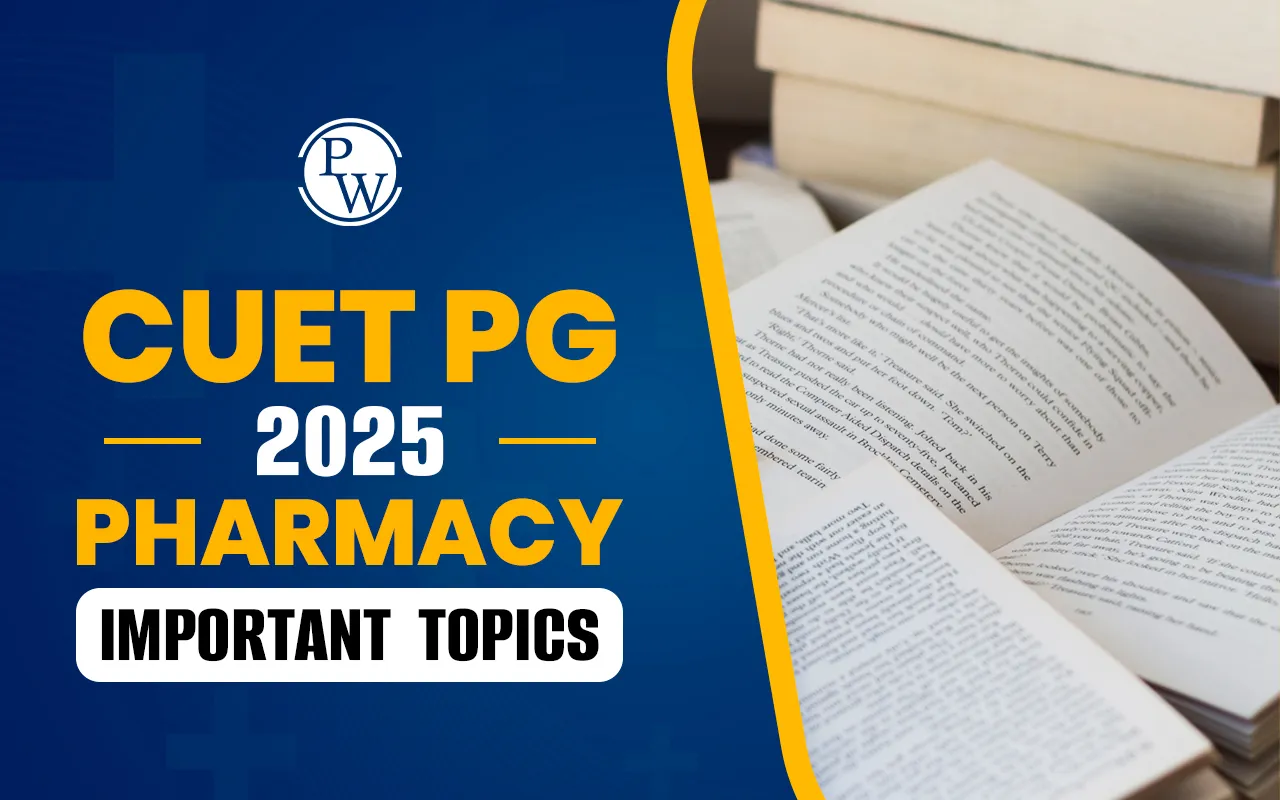CUET PG 2025 Pharmacy Important Topics: The CUET PG Pharmacy Exam 2025 will be conducted by the National Testing Agency (NTA) between March 13 and March 31, 2025. This exam is a national-level entrance test for admission to postgraduate pharmacy programs, such as M.Pharm, offered by various Central and participating universities. Candidates planning to appear for the CUET PG Pharmacy Exam 2025 should know the important topics for their preparation.
Knowing CUET PG 2025 Pharmacy topics is important as it helps students focus on the areas with the most weightage, understand the exam pattern, and manage their study time effectively. Understanding the CUET PG Pharmacy Important Topics ensures better preparation and higher chances of success in the exam. Candidates can find the CUET PG 2025 Pharmacy Important Topics, detailed syllabus PDF, preparation tips, and more below.

CUET PG 2025 Pharmacy Important Topics are essential for students preparing for the exam. These topics cover the areas most likely to appear on the test, allowing students to focus their study efforts on what matters most.
CUET PG Pharmacy Exam 2025 includes 75 subject-specific topics, which are available in both English and Hindi. Knowing these important topics helps students manage their study time wisely and prioritize what to learn first.
Focusing on these key topics helps improve understanding, boosts exam performance, and increases confidence. It also reduces stress by making preparation more organized. Students can check the complete list of CUET PG 2025 Pharmacy Important Topics below to help guide their studies.
CUET PG Pharmacy Exam 2025 is a national-level entrance exam for students who want to pursue a Master's degree in pharmacy or related fields at participating universities. The table below provides an overview of the CUET PG Pharmacy Exam 2025:
|
CUET PG Pharmacy Exam 2025 Overview |
|
|
Aspect |
Details |
|
Name of the Exam |
CUET PG Pharmacy Exam 2025 |
|
Exam Conducting Body |
National Testing Agency (NTA) |
|
Mode of the Examination |
Computer-Based Test (CBT) |
|
Medium/Language |
English and Hindi |
|
Duration of the Examination |
90 Minutes |
|
Frequency of Exams in a Year |
Once a year |
|
Types of Questions |
Multiple Choice Questions (MCQs) |
|
Total Number of Questions |
75 questions |
|
Questions Based on |
Domain-Specific Topics |
|
Total Marks |
300 |
|
Negative Marking |
Yes |
|
Admit Card Release |
Four days before the examination date |
|
Exam Dates |
March 13, 2025, to March 31, 2025 |
|
Official Website |
exams.nta.ac.in/CUET-PG |
CUET PG 2025 Pharmacy exam covers a wide range of topics across various subjects, each essential for mastering the pharmaceutical sciences. The table below lists important topics across various pharmacy subjects, making it easier for candidates to prioritize their preparation for CUET PG 2025.
|
List of CUET PG 2025 Pharmacy Important Topics |
|
|
Subject |
Important Topics |
|
Pharmaceutics-I (Introduction to Pharmaceutics) |
History of pharmaceutical practice, Pharmacopoeias (Indian, British, US), Routes of administration, Pharmaceutical dosage forms, Plant extract preparation methods. |
|
Pharmaceutical Chemistry-I (Organic-I) |
Organic reactions classification, Stereochemistry, Reaction mechanisms (Addition, Elimination, Substitution), Effect of substituent groups. |
|
Pharmaceutical Chemistry-II (Inorganic) |
Pharmaceutical inorganic compounds (Sodium, Potassium, Iron), Metal compounds in medicine, Role of electrolytes, Biomedical uses of lithium, platinum compounds. |
|
Advance Mathematics |
Differential equations, Laplace transforms, Biometrics, Probability, Correlation & Regression analysis. |
|
Pharmaceutics-II (Physical Pharmacy) |
Matter and its properties, Micromeritics, Surface and Interfacial phenomena, Rheology, Colloids, Complexation and protein binding, Chemical kinetics. |
|
Pharmaceutical Chemistry-III (Organic-II) |
Heterocyclic compounds, Pericyclic reactions, Oxidation & reduction, Organic synthesis reagents, Bio-macromolecules chemistry. |
|
Pharmaceutical Microbiology |
Microbial classification, Identification, Microbial control methods, Immunity mechanisms, Microbial assays of antibiotics & vitamins. |
|
Anatomy, Physiology & Health Education-I |
Human cell structure, Body tissues, Osseous and hematopoietic systems, Cardiovascular system, Balanced diet, Demography & family planning, First Aid. |
|
Pharmaceutics-III (Pharmaceutical Engineering) |
Unit operations, Size reduction, Size separation, Mixing, Filtration, Crystallization, Distillation, Refrigeration & humidity control. |
|
Pharmaceutics I (Dispensing & Community Pharmacy) |
Prescription reading, Pharmaceutical calculations, Dosage forms (ointments, creams, tablets, suppositories), Community & hospital pharmacy. |
|
Pharmaceutical Analysis-I |
Quantitative analysis, Oxidation-Reduction titrations, Gravimetric analysis, Precipitation titrations, Non-aqueous titrations. |
|
Pharmacognosy-I |
Definition and scope, Crude drug classification, Active constituents (carbohydrates, lipids, resins), Plant hormones and applications, Pest control agents. |
|
Anatomy, Physiology & Health Education-II |
Nervous systems (CNS, ANS), Respiratory, Endocrine, Digestive, Reproductive, Urinary systems, Sense organs. |
|
Pharmaceutics-V (Dosage Form Design) |
Pre-formulation studies, Formulation additives, Stability studies, Polymers, Dissolution technology, Solubilization. |
|
Pharmaceutical Analysis-II |
Conductometry, Potentiometry, Polarography, Coulometry, Radioimmunoassay, X-ray diffraction, Thermal methods. |
|
Pharmaceutical Chemistry-IV (Biochemistry) |
Enzymes and coenzymes, Carbohydrates and lipid metabolism, Biological oxidation, Protein synthesis, Metabolism of ammonia and nitrogen. |
|
Pharmacognosy II |
Glycosides (Saponins, Cardiac steroids), Plant bitters, Sweeteners, Biological sources, Enzymes, Chemical tests for identification. |
|
Pharmaceutical Jurisprudence & Ethics |
Pharmaceutical legislation (Pharmacy Act 1948, Drugs & Cosmetics Act 1940), Narcotic Drugs Act, Intellectual Property Rights, Marketed pharmaceutical products. |
|
Pharmaceutics-VI (Cosmetic Technology) |
Formulation of cosmetics (Face, Skin, Hair products), Herbal cosmetics, Baby care products, Cosmetic packaging, Evaluation methods. |
|
Pharmaceutics-VII (Pharmaceutical Technology-I) |
Liquid & semisolid dosage forms, Suspensions & emulsions, Suppositories, Solid dosage forms, Pharmaceutical aerosols, Blood products, Plasma substitutes. |
|
Pharmaceutical Chemistry-V (Medicinal Chemistry-I) |
Neurotransmission drugs, Immune system drugs, Respiratory drugs, Miscellaneous agents, Pharmaceutical aids. |
|
Pharmacognosy-III |
Alkaloid-containing drugs, Aromatic plants, Marine pharmacognosy, Chromatographic methods, Ayurvedic preparations. |
|
Pharmacology-I |
General pharmacology, Drug absorption & distribution, Pharmacokinetics, Drug interactions, Pharmacogenetics, Clinical trials, Bioavailability studies. |
|
Pharmaceutics-VIII (Pharmaceutical Technology-II) |
Microencapsulation, Parenteral products, Controlled release formulations, Ophthalmic preparations, Novel drug delivery systems. |
|
Pharmaceutical Biotechnology |
rDNA technology, Enzyme immobilization, Vaccine technology, Fermentation processes, Biotech product production & purification. |
|
Pharmaceutical Chemistry-VI (Medicinal Chemistry-II) |
CNS affecting drugs, Thyroid hormones, Insulin & Hypoglycemics, Water-soluble vitamins, Steroidal agents, Hematopoietic drugs. |
|
Pharmaceutics-IX (Packaging Technology) |
Packaging of solid, semisolid, and topical dosage forms, Glass, plastic & metal packaging, Tamper-resistant & child-resistant packaging. |
|
Pharmacology-II |
CNS diseases drugs, Endocrine system drugs, Hematopoietic drugs, Drug addiction, Drug abuse, Antiepileptics, Antidepressants, CNS stimulants. |
|
Pharmaceutics-X (Biopharmaceutics & Pharmacokinetics) |
Gastrointestinal absorption, Drug absorption factors, Biotransformation, Pharmacokinetic parameters, Bioavailability & Bioequivalence studies. |
|
Pharmaceutical Chemistry-VII (Medicinal Chemistry-III) |
Drug design and development, Cardiovascular drugs (anti-anginal, antihypertensive), Chemotherapeutic agents (antibiotics, anticancer, antivirals). |
|
Pharmacology-III |
Pathophysiology of microbial diseases, Chemotherapy, Anti-microbial agents, Anti-parasitic drugs, Antibiotics, Antimalarial drugs, Antifungal agents. |
CUET PG Pharmacy Syllabus 2025 has been officially announced. Students can refer to the syllabus to understand the important topics and areas that will appear in the exam. It also includes details on the subjects and the expected weightage of questions, helping students plan their study routine better. Candidates can download the CUET PG Pharmacy Syllabus 2025 in PDF format through the link below to stay prepared for the exam:
Click Here to Download CUET PG Pharmacy Syllabus 2025 PDF
To perform well in the CUET PG 2025 Pharmacy exam, it is essential to adopt a strategic approach to your preparation. The following are some effective tips to help you stay on track and maximize your chances of success:
1. Understand the Exam Pattern: Familiarize yourself with the CUET PG exam pattern, including the number of questions, marking scheme, and time limits. This will help you strategize your preparation effectively.
2. Focus on Core Subjects: Concentrate on key subjects like Pharmaceutics, Pharmaceutical Chemistry, Pharmacology, and Pharmacognosy. Make sure to understand the fundamental concepts and their applications.
3. Practice with Previous Year Papers: Solve CUET PG Pharmacy Previous Year Question Papers to understand the question format, difficulty level, and commonly tested topics. This will help you manage time and identify important areas to focus on.
4. Revise Regularly: Regular revision is crucial to retaining what you learn. Set aside time each week to review topics and reinforce your understanding.
5. Time Management: Develop a study schedule and allocate specific time for each subject. Make sure to include time for practice tests and revision.
6. Refer to Standard Study Material: Use recommended textbooks, reference books, and online resources for each subject. Stick to a few quality resources to avoid confusion.

